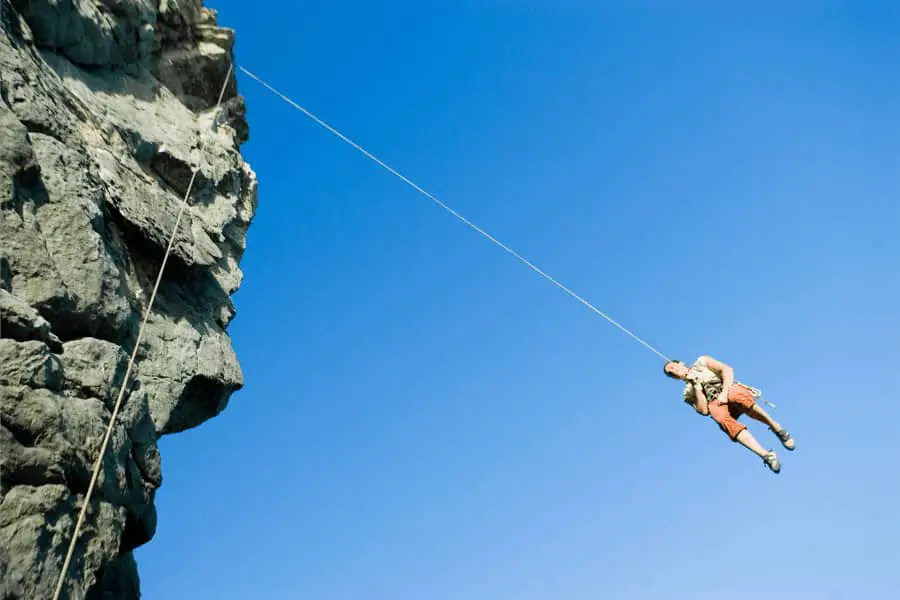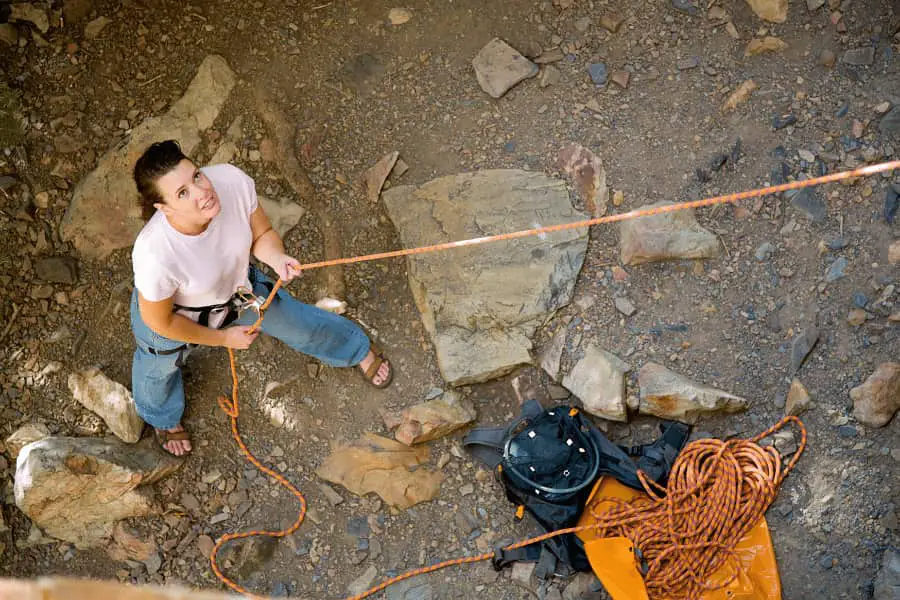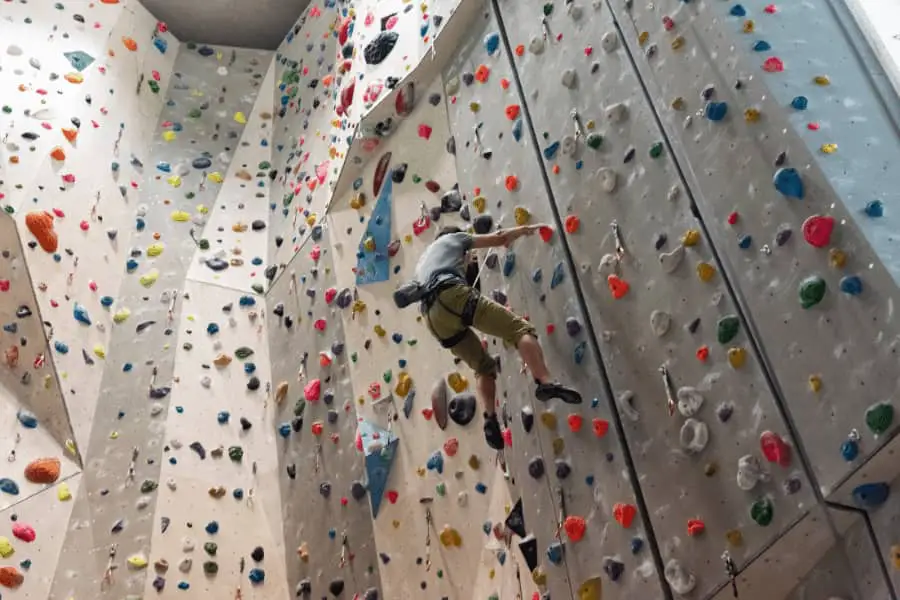
When I first started lead climbing I was very nervous to take a fall. I was in the same boat as many climbers that are starting to transition from top rope to lead climbing. Luckily enough for me, I had experienced climbers around me that were able to help me through this process.
To get over you fear of falling while lead climbing you will need to practice taking falls. Reach out to an experienced belayer you trust and start with small and controlled falls. After practicing small falls, you can work your way up to longer ones and eventually transition to falling outside.
In the sections below I detail all 10 helpful tips given to me by experienced climbers that were able to help me get over my fear of falling while lead climbing.
Every climber needs to have a harness they feel comfortable taking a fall in, check out the current price of the top climbing harnesses on Amazon here! (affiliate link)
1. Learn How To Fall Safely
Learning how to fall safely is something every climber needs to do before they start lead climbing. This is the first step for a reason. You should complete this step before you go out and attempt to lead climb your first route. Falling improperly can lead to injuries and further increase your fear of falling.
I wrote an entire article dedicated to this topic to really hammer home how important this is. If you are interested in checking that out, you can see it linked here. I recommend reading that if you have never been taught how to correctly fall when lead climbing. Having that knowledge will be essential to every route you lead climb in the future.
If you just got back from reading that article or if you already know how to fall safely, I will give you a brief refresher on what to do and what not to do when taking a fall.
Do the following when taking a fall lead climbing:
- Identify no fall zones
- Keep the rope between you and the wall
- Shout “watch me” if you think you may fall soon
- Shout “falling” when you come off the wall
- Fall straight down
- Bend your knees and arms slightly
- Breathe and stay loose
- Sit into the harness
- Prepare to make contact with the wall
Do NOT do the following when taking a fall lead climbing:
- Be quiet
- Push yourself off the wall when falling (unless there is something dangerous directly below you)
- Lean too far back and flip yourself over
- Tense up when falling
- Reach out to holds and try to catch yourself
Learning how to fall safely will give you the confidence that when you do fall, you will not be putting yourself at any additional risk. This can be a comforting fact when you first start lead climbing. Knowing that you will be falling the safest way should put you somewhat at ease.
2. Reach Out To An Experienced Belayer

Having an experienced belayer when you first start lead climbing will make all the difference on the world. Ideally they will have caught hundreds to thousands of falls before and will provide you with soft catches.
When I first started lead climbing this was the thing that helped me out the most when taking falls. Having complete and total trust in your belayer is essential. It is such a weight off of your shoulders to know that the person responsible for catching you is terrific at what they do.
If you don’t know any experienced belayers, you can reach out to belayers in the gym that look like they know what they are doing. Most belayers will be happy to help you out. You just have to tell them what you are want to do straight up: get over your fear of falling. The climbing community is full of a bunch of great people who are willing to help each other out.
Just don’t expect them to drop everything that they are doing right away. You may have to wait around a bit before they are ready to help you. If asking random people makes you nervous, you can reach out to the gym staff and see if any of them are available to belay for a bit.
Having someone you trust on the other end of the rope is essential when taking your first few falls. Do not ignore this tip. It was the one that helped me out the most by far.
3. Start By Falling In The Gym
Do not be mistaken, the only way to truly get over your fear of falling is to fall. And fall a lot. That being said, there are ways to make this easier on yourself starting out. Beginning your falling journey in the gym is one of these ways.
Falling in the gym is the perfect place to start falling. The gym will eliminate all other potential distractions. It will just be you, the wall, and the belayer. You will not have to worry about any potential rocks below you and the floor is padded. On top of this, you should feel confident that the clips will hold you when you fall. The equipment is less likely to pull out of the gym wall than with rock. (Equipment shouldn’t pull out of rock either if it is set properly).
The gym is the most controlled atmosphere to start lead climbing in. Some climbers have said that falling in the gym does not help them when falling outside. I disagree. I think practicing in the gym is a great way to start falling. It allows you to start getting the hang of the process of falling in an environment less challenging mentally than being outside. This will help build muscle memory when transferring outside.
4. Initially Only Fall Below The Clip
Like with everything else in life, you have to crawl before you can walk. This is the equivalent of crawling when taking falls lead climbing. This is the first step in a long journey of taking falls.

Falling below the clip will be very similar to taking a fall top roping. The clip will be above you and you will not have to worry about falling very far before your belayer will catch you. This is where having an experienced belayer will really come in handy. Inexperienced or bad belayers will have difficulties giving climbers soft catches on short falls. An experienced belayer will be able to do this properly.
When doing this, I recommend that you pick a route that is well within your current climbing abilities. That way you can climb just shy of halfway up it with ease and not worry about falling off at the start. To fully immerse yourself in the falling experience, you will want to be up the wall a bit and not completely at the bottom. This will put your mind in the “okay I’m actually climbing” headspace.
Once you are up the wall a bit (not to the top), clip in above your head and get ready to fall. Once you are ready to give it a go, shout “falling” and peel off the wall. Be sure to sit into the harness and not to push yourself out too far. Congratulations in advance for successfully falling!
If actually letting go of the hold is difficult for you I recommend trying what my friend did.
Close your eyes, take a few deep breathes and count to three. Once you hit three, shout falling and let go. I know this sounds cheesy but it actually worked for my friend. She had extreme anxiety over falling and by doing this, she was able to relax herself enough to fall like a champ. (if this tip doesn’t help you and you still aren’t able to let go of the holds, skip down to tip number 9).
Once you have been able to figure out how to take your first small fall, it is off to the races.
5. Increase The Distance You Fall From

Once you have started to become comfortable with falling from below the clip, climb up such that your hip is at the same level as the clip. This will be new territory for you. You will now not be taking falls similar to top rope, these are lead climbing falls now. Continue to do this and fall from this height until you are comfortable with it.
After you have mastered hip level, it is time for the big leagues. You will now start to climb above the clip and take falls from there. Keep in mind, you will fall twice the distance between you and the clip. That is important to keep in mind so that you start small.
Don’t climb up 3 feet above your last clip and fall from there before you have fallen from 1 foot above your last clip. Building confidence is key here. As the falling distance exponentially gets bigger, so will your time in the air. Make sure you are very comfortable with the level you are falling at above your clip before you go further up.
6. Fall In The Gym A Lot
This is the “fun” part! Falling and falling again. Think you have fallen enough? Guess again. Let go of those holds over and over again.
Practicing falling over and over again will help you get comfortable and familiar with different distances. This will also allow you to get a better feel for how you belayer is catching you. Are they giving you a soft or a hard catch? Does their catch differ when you shout falling vs when you don’t?
Becoming intimately familiar with falling and how your belayer catches you is incredibly useful when lead climbing. This will help you build trust and comfort not only in your belayer but also in yourself. In addition to this, when you have different belayers you can start to notice what you like and what you don’t. This will help your own belaying skills as well indirectly.
Becoming confident and familiar with your gear also takes place during this time. You will learn to trust your gear. The draws, rope, and harness all have to meet minimum safety requirements to be sold and used. By using these more and more, you will become more sure that they will function properly. Trust your gear.
7. Get Better At Clipping In
Increasing your skill at clipping in will have you feeling confident that you can get to the next clip safely and not take a huge fall. If clipping in is slow and cumbersome for you to do still, I highly recommend practicing this.
Clips can be spaced 2-3 meters apart (6 to 10 feet) on average. If you are having troubles clipping in to the next draw, you will be extending the time and therefore the likelihood that you will fall off from that distance. Remember, you will fall twice the distance between you and the last clip. Falling from 10 feet above your last clip will be a 20 foot fall in total.
Practicing clipping and being able to do it blindfolded will lower the chance that you will fall from large distances. You will be able to clip into the next draw and be on your way without a second thought.
8. Attempt Routes Harder Than You Can Climb
If you are unable to get over your anxiety and physically let go fo the route, this tip is the tip for you. Climb a route outside of your current climbing ability. By starting something you are physically unable to finish, you will fall. However, you may not be able to control when you do and therefore you may take a larger fall than you would if you chose what spot to fall on.
This is beneficial to do once you have already become comfortable with varying distances in the gym. The randomization fo when you take a fall will get you comfortable for actually falling on routes. In the real world you will not have the luxury of choosing when you are going to peel off of a route.
9. Start Falling Outside
Once you are very comfortable with clipping in and falling in the gym, it is time to start falling outside.

As mentioned previously, some climbers feel that falling outside is completely different and more nerve wrecking than falling in the gym. I tend to agree with this. However, if you have followed all of the other tips up until this point, you have nothing to worry about.
By falling all of those times in the gym, you will have built a great base for falling outside. You technique will be on point, you will be confident with your belayer, and you will trust your gear.
The main difference when to consider falling outside is what is beneath you. With the gym, you likely did not have to worry about anything being beneath you. Outside it will be critical to identify no fall zones. zones where you do not want to take a fall due to some underlying feature.
If you identify a no fall zone due to sharp rocks below, this may be the one time that you will need to push off of the wall. Pushing off of the wall may allow you to avoid the rocks; however, watch out as you be taking a whipper. A whipper is where you pendulum your self back into the wall.
If this happens, just be sure to stop yourself with your feet first and then your hands. This should only happen in rare cases but it something that you should be made aware of. Catching the face of the wall a little hard is much better than falling on sharp rocks.
To avoid this your first time out, try to find overhangs or flat vertical faces to climb on. That will eliminate the need to even worry about that.
10. Focus On Climbing And Not Clipping
The last tip that was given to me to help me get over my fear of falling is to focus on the climb and not the clips. By focusing on clipping you will not be able to climb at your true ability and will stress yourself out. If you have followed tip number 7, clipping should be second nature for you.
Climbing is such a fun sport and lifestyle to worry about the little things. Focus on making the moves and enjoying the moment. If you fall off then so be it. When the opportunity to clip in arises, do it and move on.
Climbing isn’t about clipping, its about sending the route. Don’t stress too much about where you are in relation to your last clip. Focus on what comes next. Do this, and you will greatly reduce the anxiety you have towards falling.
The bottom line? The only way to truly get over your fear of falling when lead climbing is to practice taking falls. Having an experienced belayer that you trust will help you mentally when taking your first few falls. starting with smaller and more controlled falls first will help you build confidence for longer falls.
